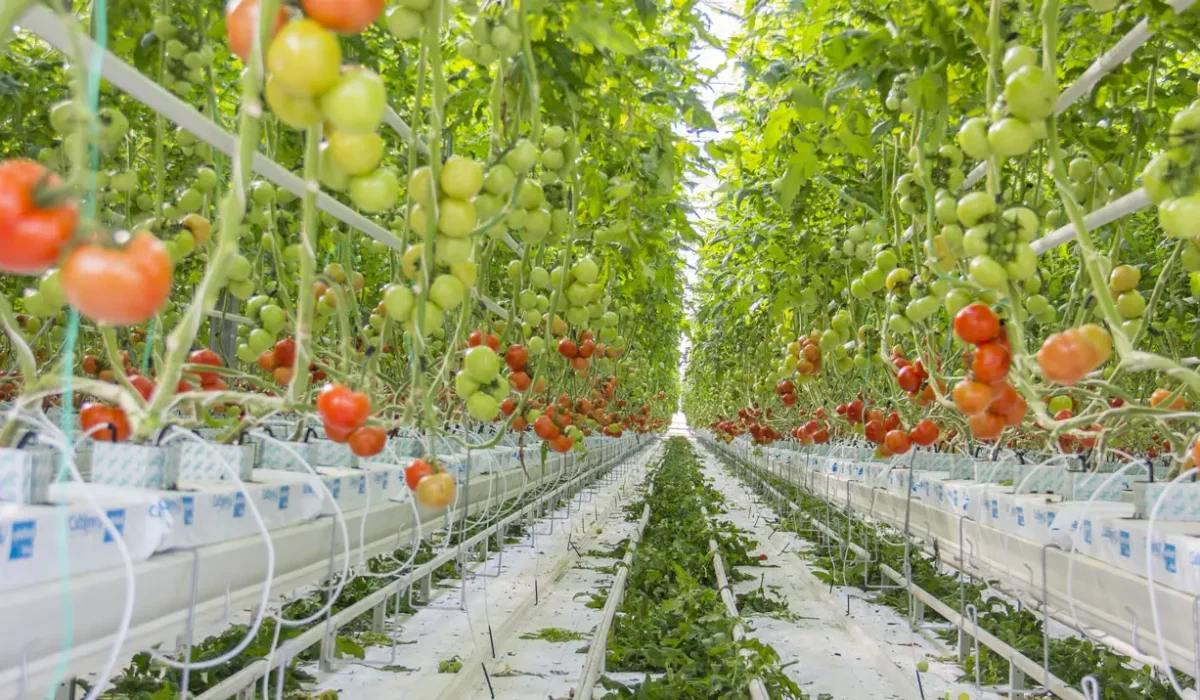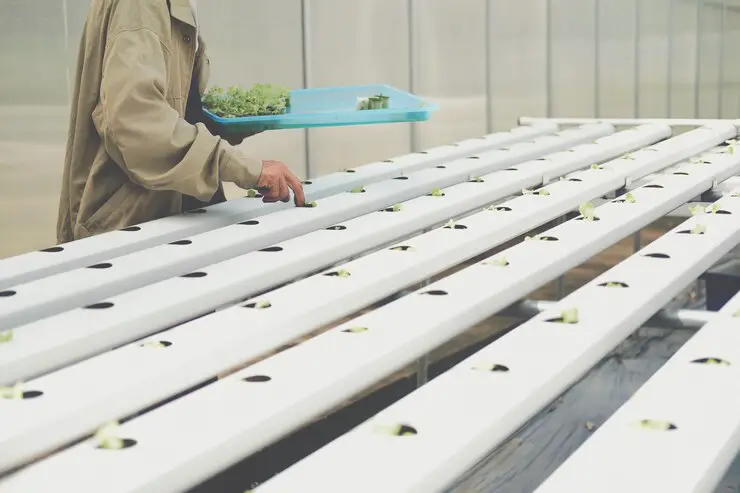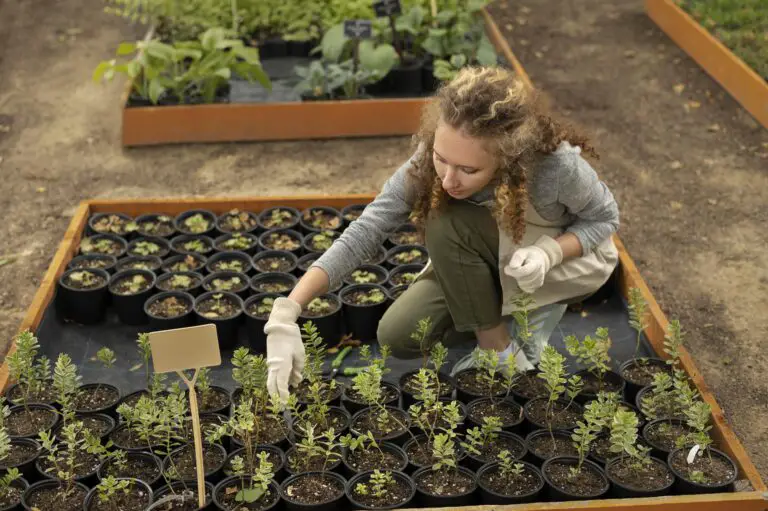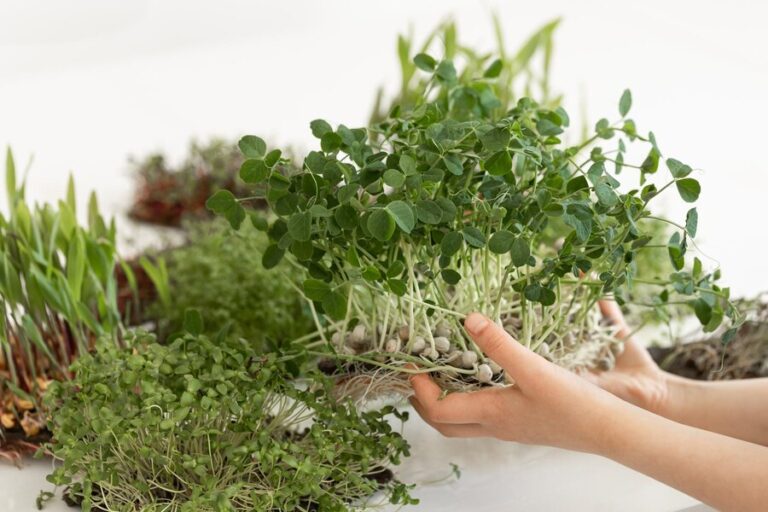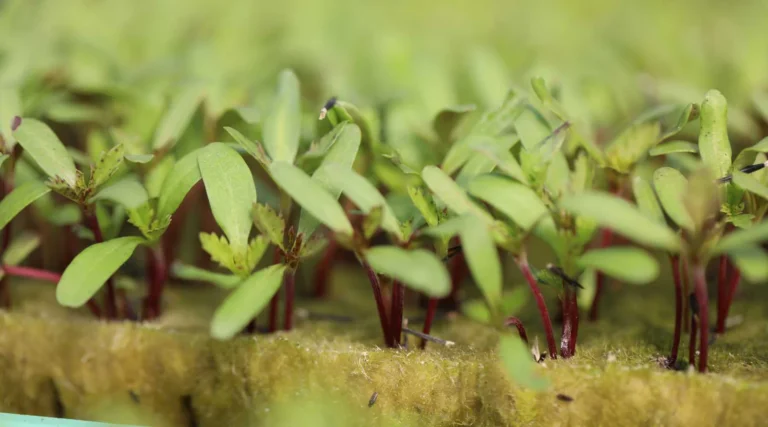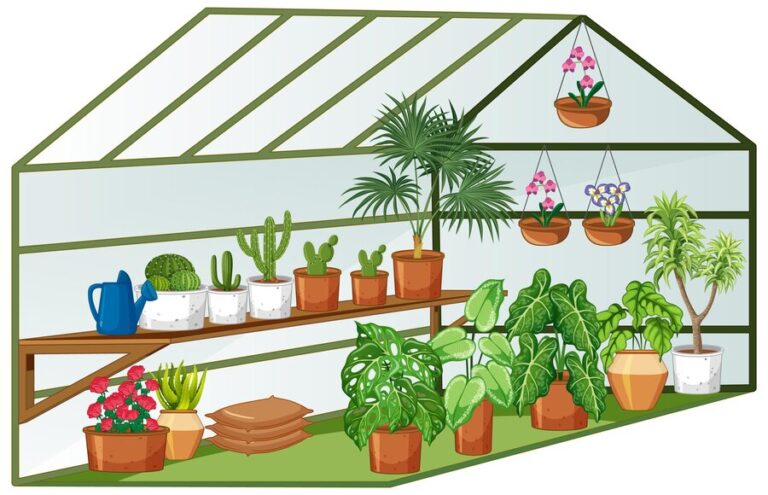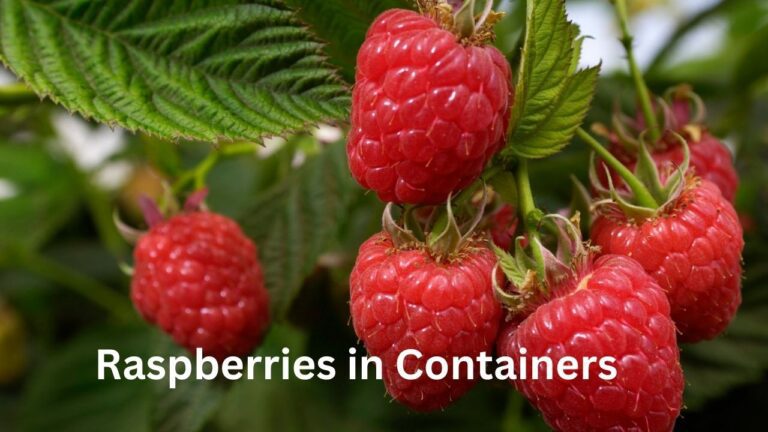How to Grow Hydroponic Tomatoes Without Pollination: A Step-by-Step Guide
Do you ever wonder how you can grow delicious hydroponic tomatoes without the need for pollination? It’s not magic—it’s science! In this step-by-step guide, we’ll explore the fascinating world of hydroponic tomato cultivation, uncovering the secrets to success without relying on bees or other pollinators. From selecting the right variety to mastering nutrient solutions, we’ve got you covered. Whether you’re a seasoned hydroponic enthusiast or a curious beginner, this guide will equip you with the knowledge and confidence to grow juicy, flavorful tomatoes year-round. Get ready to embark on a tomato-growing adventure like never before!
Table of Contents
The Importance of Pollination in Traditional Tomato Cultivation
Pollination plays a crucial role in the traditional cultivation of tomatoes. It is the process by which pollen is transferred from the male reproductive organs of a flower to the female reproductive organs, leading to fertilization and fruit production. In the case of tomatoes, the transfer of pollen occurs through the action of bees and other pollinators.
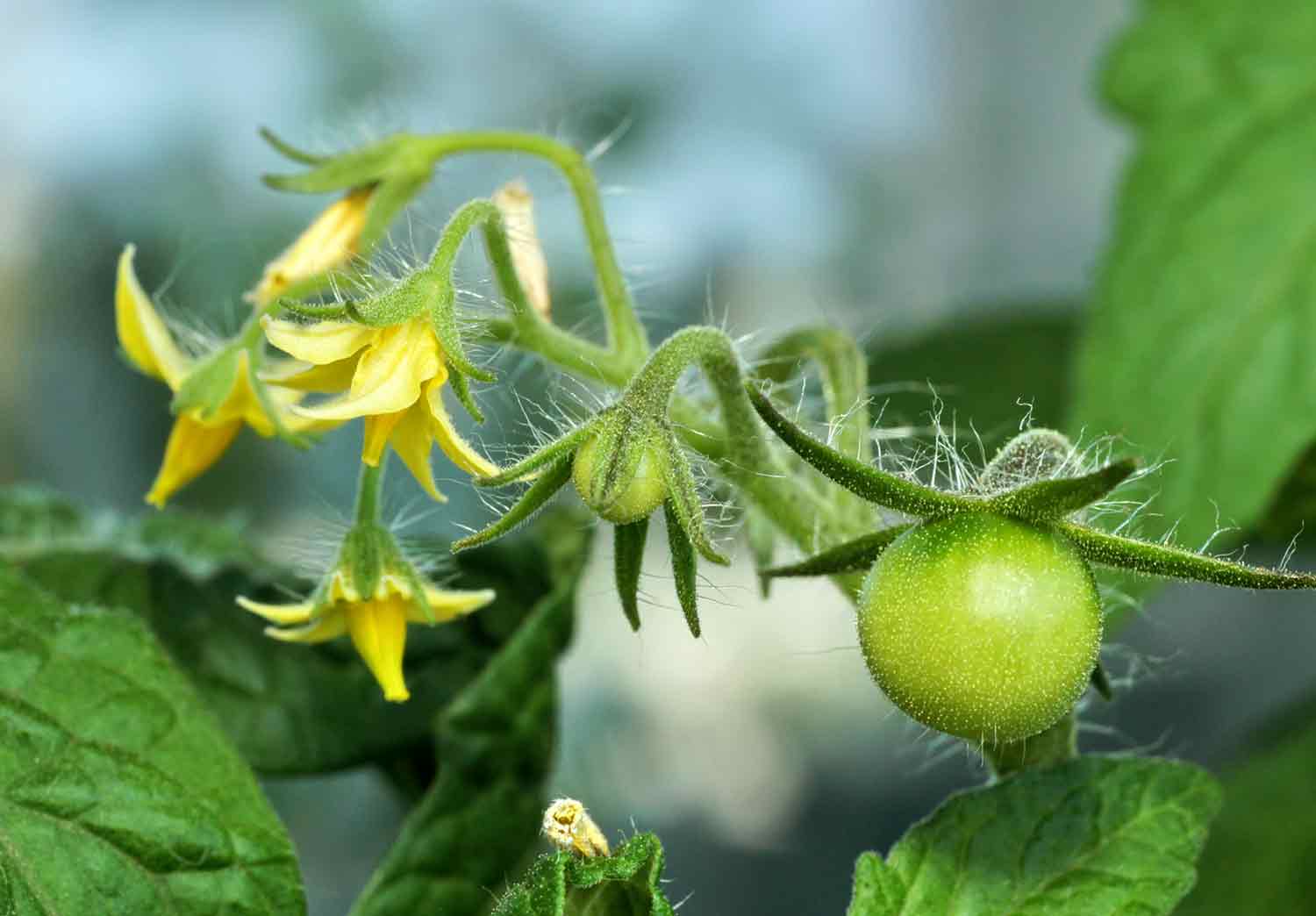
- Essential for Fruit Development: Pollination ensures the development of healthy and robust tomato fruits by facilitating the formation of seeds, vital for future plant generations.
- Contributes to Plant Health: Proper pollination leads to the even distribution of hormones, nutrients, and growth regulators, enhancing overall plant health and productivity.
- Impact on Yield and Fruit Quality: Inadequate pollination can result in reduced fruit production and inferior-quality fruits, affecting harvests and profits for farmers and gardeners.
- Creating Pollinator-Friendly Environments: To maximize pollination benefits, it’s crucial to attract and support pollinators by planting flowering plants nearby and avoiding harmful pesticides harmful to bees and other pollinating insects.
In conclusion, understanding the importance of pollination in traditional tomato cultivation is essential for gardeners and farmers alike. By promoting pollinator-friendly practices, we can ensure the success and sustainability of tomato cultivation, leading to bountiful harvests and nutritious, flavorful tomatoes for all.
Exploring Pollination-Free Hydroponic Techniques
Hydroponics has revolutionized modern agriculture by providing an efficient and sustainable method of growing plants without soil. However, one key challenge faced by hydroponic tomato cultivators is the need for pollination.

Manual Pollination:
- In hydroponic systems, where natural pollinators are absent, manual pollination is a crucial technique.
- It involves transferring pollen from the male flowers to the female flowers by hand.
- The goal is to mimic the natural pollination process and ensure fruit development.
- Growers can use a small brush or cotton swab to gently transfer pollen to the stigma of the female flower.
- By doing so, they facilitate fertilization and fruit set in the absence of bees or other pollinators.
This method requires careful observation of flower development and precise timing, as tomatoes have a short period during which they are receptive to pollination. However, with practice and attention to detail, manual pollination can effectively replace natural pollination in hydroponic systems and yield high-quality tomatoes.
Selecting the Right Tomato Variety for Hydroponic Growth
When selecting the right tomato variety for hydroponic growth, it is important to consider several factors that can contribute to the success of your cultivation.
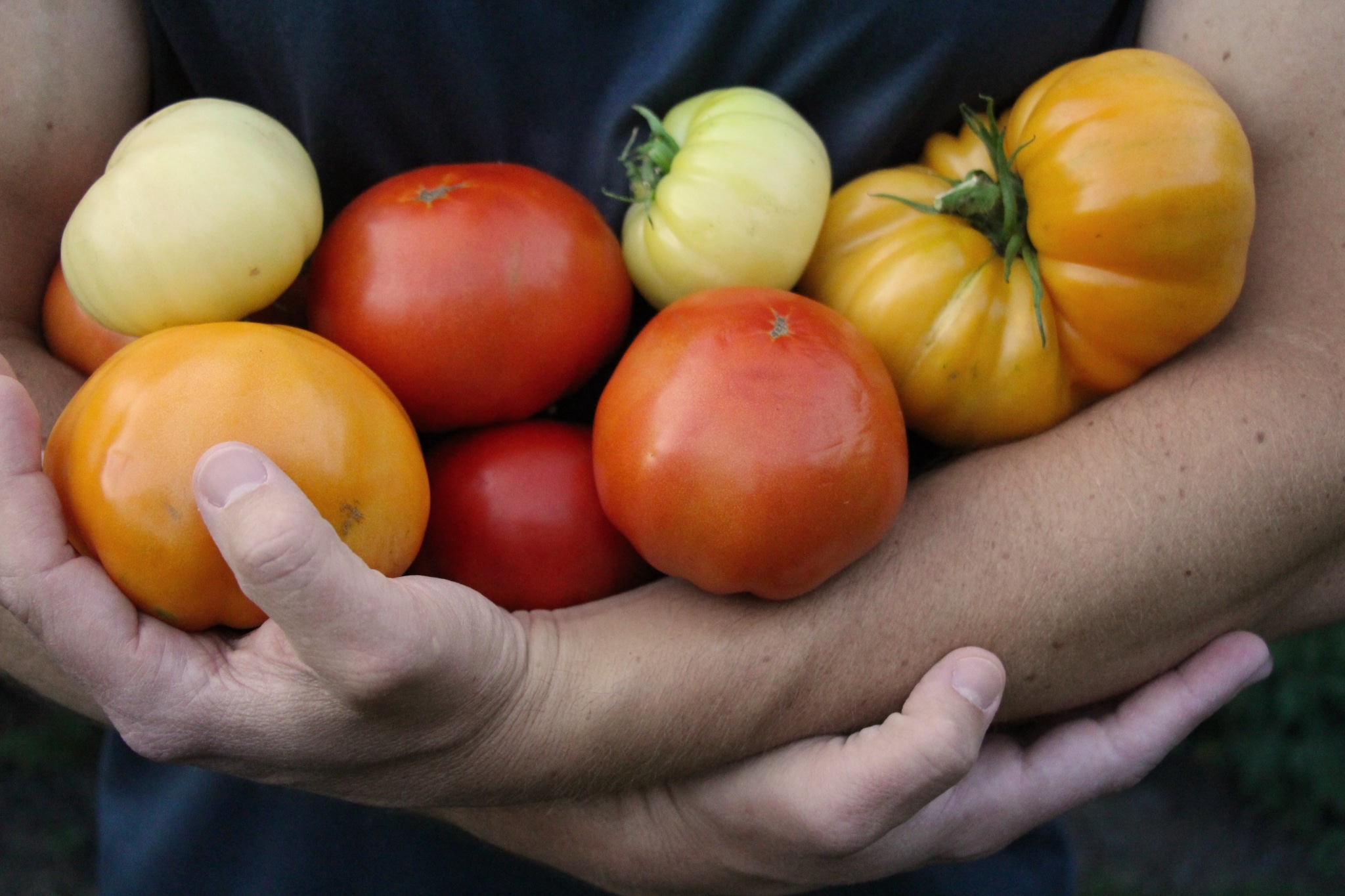
- Growth Habit and Size: Consider the plant’s growth habit and size. Determinate varieties are preferred for their compact size and uniform fruit ripening, while indeterminate varieties may require additional support and space management due to their sprawling habit.
- Time to Maturity: Select varieties with a shorter time to maturity to maximize yield in hydroponics, where the growing season can be extended or regulated.
- Fruit Characteristics: Consider desired fruit characteristics such as size, taste, and color. Choose from a variety of options, ranging from small cherry tomatoes to beefsteak tomatoes, each offering unique flavors and visual appeal.
- Consult Reliable Sources: Consult seed catalogs or reliable online sources for detailed information on each variety’s characteristics, including disease resistance, yield potential, and specific requirements for hydroponic cultivation.
By carefully considering these factors and selecting the right tomato variety for your hydroponic system, you can ensure optimal growth and achieve a bountiful harvest.
Creating the Ideal Hydroponic Environment for Tomato Cultivation
To create the ideal hydroponic environment for tomato cultivation, several factors must be considered. First and foremost, it is essential to provide optimal lighting conditions.

- Tomatoes require a minimum of 12 hours of high-intensity light each day for proper growth and fruit production.
- High-pressure sodium (HPS) or LED grow lights are the recommended options due to their ability to provide the necessary spectrum of light wavelengths.
- In addition to lighting, maintaining suitable temperature levels is crucial in hydroponic tomato cultivation.
- Tomatoes thrive in temperatures between 70-75°F (21-24°C) during the day and slightly cooler temperatures of 60-65°F (15-18°C) at night.
- Maintaining a consistent and controlled temperature within this range promotes optimal growth and prevents stress-related issues such as poor fruit set or diseases.
- Utilizing air conditioning, fans, or ventilation systems can help regulate the temperature within the hydroponic environment and contribute to a healthy tomato crop.
Choosing the Right Hydroponic System for Pollination-Free Growth
When it comes to choosing the right hydroponic system for pollination-free growth of tomatoes, there are several factors to consider.
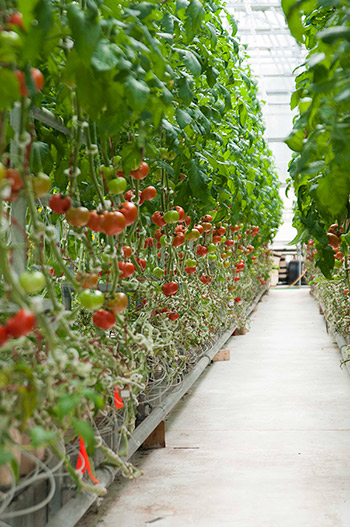
- Sturdy Support Structures: Ensure the hydroponic system provides adequate support for growing tomato plants, as they can become large and heavy. Sturdy trellising or support structures are essential to prevent plant damage.
- Nutrient Delivery: Choose a system capable of delivering necessary nutrients and water without relying on traditional pollination methods. Opt for nutrient-rich solutions and efficient irrigation methods to support plants growth.
- Consider Available Space and Resources: Evaluate available space and resources to determine the most suitable hydroponic systems. Different systems have varying space requirements and may require specific equipment or infrastructure.
- Explore Hydroponic System Options: Research various hydroponic systems available, such as nutrient film technique NFT, DWC, and aeroponics, to understand their advantages and disadvantages. Select the system that best aligns with your needs and goals for tomato cultivation.
Choosing the right hydroponic system for pollination-free growth of tomatoes is a key step in ensuring successful cultivation. By considering factors such as support, nutrient delivery, available resources, and exploring different system options, you can create an ideal environment for your tomato plants to thrive.
“DIY Hydroponic Gardens: How to Design and Build an Inexpensive System for Growing Plants in Water” has been a revelation in my gardening journey. Following the step-by-step instructions and creative ideas presented in the book, I was able to construct my own hydroponic system with ease. From repurposing materials to selecting the right plants, every aspect was covered comprehensively, empowering me to create a thriving soilless garden at a fraction of the cost of commercial systems.
The book’s emphasis on affordability and versatility made hydroponic gardening accessible to me, even with limited space and resources. I appreciated the troubleshooting tips and educational content, which helped me navigate challenges and optimize my system for maximum success. Whether you’re a beginner looking to dip your toes into hydroponics or an experienced gardener seeking innovative DIY solutions, “DIY Hydroponic Gardens” is a valuable resource that will inspire and guide you towards creating your own flourishing water-based garden.
- Affordable Solutions: Offers cost-effective DIY methods for building hydroponic systems, making hydroponic gardening accessible to a wider audience.
- Comprehensive Guide: Provides a comprehensive guide to designing, building, and maintaining hydroponic systems, suitable for beginners and experienced gardeners alike.
- Step-by-Step Instructions: Presents clear, step-by-step instructions accompanied by illustrations and photographs, making it easy to follow along and implement the techniques.
- Versatility: Covers a variety of hydroponic systems, including deep water culture, nutrient film technique, and media-based systems, offering options to suit different preferences and space constraints.
- Creative Ideas: Offers creative ideas for repurposing materials and resources to construct DIY hydroponic setups, encouraging innovation and sustainability.
- Plant Selection: Provides guidance on selecting suitable plants for hydroponic cultivation, as well as tips for optimizing plant health and growth in a soilless environment.
- Troubleshooting Tips: Includes troubleshooting tips and solutions for common issues encountered in hydroponic gardening, helping readers overcome challenges and achieve success.
- Educational Content: Offers educational content on hydroponic principles, nutrient management, and environmental control, empowering readers with valuable knowledge and skills.
- Inspiring Success Stories: Features inspiring success stories and case studies of DIY hydroponic gardeners, providing motivation and practical insights for readers embarking on their own hydroponic journey.
- Limited Depth: Some readers may find that certain topics are covered superficially, lacking in-depth information or advanced techniques.
- Resource Availability: Availability of materials and resources for DIY hydroponic projects may vary depending on location, making it challenging for some readers to replicate the designs exactly.
- Skill Requirement: Requires basic DIY skills and tools for construction, which may be intimidating for readers with limited experience in building or plumbing.
- Space Limitations: Some DIY hydroponic systems may require ample space for setup and operation, which may not be feasible for gardeners with limited indoor or outdoor space.
- Maintenance: DIY hydroponic systems require regular maintenance to ensure proper function and prevent issues such as nutrient imbalances or system failures.
- Investment of Time: Building and maintaining DIY hydroponic systems may require a significant investment of time and effort, especially for larger or more complex setups.
- Risk of Failure: There is a risk of failure associated with DIY hydroponic projects, particularly for inexperienced builders or those who do not follow instructions carefully.
- Environmental Considerations: Some DIY hydroponic materials may have environmental implications, such as plastic usage or energy consumption, which readers should take into account.
- Dependence on Design: Effectiveness and success of DIY hydroponic systems may vary depending on the specific design, materials used, and environmental factors, requiring experimentation and adaptation.
Preparing the Hydroponic Medium for Tomato Planting
Preparing the hydroponic medium for tomato planting is a crucial step in ensuring successful growth and development of your tomato plants. The hydroponic medium serves as a replacement for traditional soil, providing the necessary support and nutrients for the plants to thrive.
Coconut coir

One popular hydroponic medium for tomato cultivation is coconut coir. Coconut coir is a byproduct of the coconut industry and is known for its excellent water retention and air porosity properties. Before using coconut coir as a hydroponic medium, it is important to soak it in water to remove any excess salts. This can be done by placing the coconut coir in a container and adding water until it is fully saturated. Allow the coir to soak for a few hours or overnight before draining and rinsing thoroughly.
Perlite
Another commonly used hydroponic medium for tomato cultivation is perlite. Perlite is a lightweight volcanic rock that provides excellent drainage and aeration for the plants’ roots. To prepare perlite for tomato planting, it is recommended to rinse the perlite with water to remove any fine particles or dust. This can be done by placing the perlite in a fine-mesh sieve and running water through it until the water runs clear. Once rinsed, the perlite is ready to be used as a hydroponic medium.
By properly preparing the hydroponic medium for tomato planting, you are creating a healthy and optimal environment for your plants to grow. Whether you choose to use coconut coir or perlite, ensuring their cleanliness and water retention capacity will greatly contribute to the success of your hydroponic tomato garden.
Sourcing High-Quality Tomato Seeds for Hydroponic Cultivation
When it comes to sourcing high-quality tomato seeds for hydroponic cultivation, it is essential to choose varieties that are well-suited for this specific growing method. With the increasing popularity of hydroponics, many seed companies now offer a wide range of tomato varieties specifically bred for hydroponic systems. These specialized seeds often exhibit traits such as disease resistance, robust growth, and high fruit yields, making them ideal for successful hydroponic tomato cultivation.

Planting Tomato Seeds in the Hydroponic System
When it comes to planting tomato seeds in a hydroponic system, there are a few key steps to follow for successful growth and development. Firstly, it’s important to select high-quality tomato seeds from a reliable supplier. These seeds should be specifically suited for hydroponic cultivation. Some popular varieties for hydroponics include ‘Roma’, ‘Beefsteak’, and ‘Cherry’ tomatoes.
- Seed Selection and Planting:
- Choose high-quality tomato seeds.
- Plant them in small rock wool cubes or net pots filled with a sterile growing medium.
- Ensure the growing medium is moist but not waterlogged to prevent issues like root rot.
- Maintain a constant temperature of 70-80°F (21-27°C) for optimal germination.
- Some gardeners use heating mat or warm, well-lit areas to achieve the right temperature.
- Moisture Management:
- Regularly mist the growing medium to maintain moisture levels.
- Avoid overwatering, as it can lead to root problems and fungal diseases.
- Lighting:
- Provide sufficient lighting for seedling growth.
- Consider using full-spectrum LED grow lights or natural sunlight.
- Proper lighting ensures healthy and robust tomato seedlings.
- Next Steps:
- Focus on optimal lighting and temperature conditions.
- Monitor and adjust nutrient levels as needed.
- Implement an appropriate watering and feeding schedule to support plant development.
By following these steps, you’ll set the stage for successful tomato cultivation in your hydroponic system. Happy growing! 🍅🌱
Providing Optimal Lighting and Temperature Conditions for Tomato Growth
Providing optimal lighting and temperature conditions is crucial for the successful growth of tomatoes in a hydroponic system. Light is an essential factor as it fuels the photosynthesis process, which enables plants to convert light energy into chemical energy and synthesize the sugars they need to grow. When cultivating tomatoes hydroponically, it is essential to ensure they receive an adequate amount of light for optimum growth and yield.
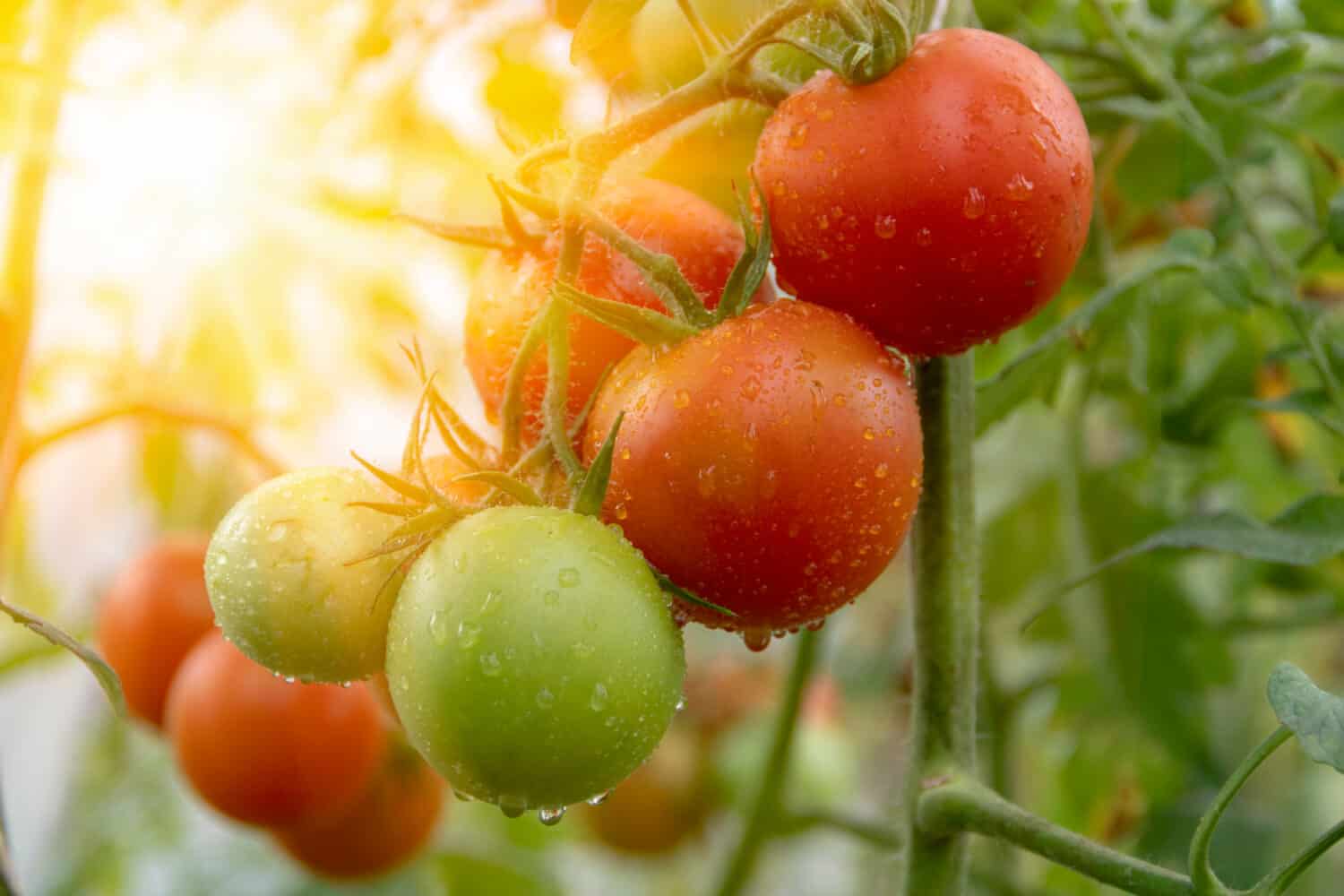
- Light Requirements: Tomatoes require at least 8-12 hours of light per day for healthy growth. LED grow lights are recommended in hydroponic setups for their energy efficiency and ability to provide the specific light spectrum needed for plant growth, particularly red and blue wavelengths to promote vegetative growth and flowering.
- Temperature Control: Maintain temperature between 70-85°F (21-29°C) during the day and slightly cooler temperatures of 60-70°F (15-21°C) at night to support optimal tomato growth in hydroponic systems. Consistent temperature regulation is vital for optimizing plant metabolism, encouraging flowering and fruit set, and reducing the risk of stress-related issues such as fungal diseases or poor pollination.
- Equipment Utilization: Use thermostats and fans to regulate temperature fluctuations and ensure a stable growing environment for tomato plants in hydroponic setups. Proper temperature control is essential for maximizing yield and overall plant health.
Maintaining the pH and Nutrient Levels in the Hydroponic Solution
Maintaining the pH and nutrient levels in the hydroponic solution is crucial for ensuring optimal growth and development of tomato plants. The pH level refers to the acidity or alkalinity of the solution and plays a vital role in nutrient availability and uptake.
Optimal pH Range: Tomatoes thrive in slightly acidic conditions, with a pH range of 5.5 to 6.5.
Regular Monitoring: Use a pH meter or test strips to monitor the pH level regularly.
Adjustments: Add pH-up or pH-down solutions to raise or lower the pH level as needed.
Essential Nutrients: Tomatoes require a balanced combination of macronutrients (N, P, K) and secondary nutrients (Ca, Mg, S).
Micronutrients: Trace elements like Fe, Mn, Zn, Cu, B, and Mo are vital.
EC and TDS Testing: Regularly test the nutrient solution’s electrical conductivity (EC) and total dissolved solids (TDS) levels.
Adjustments: Modify nutrient solutions or adjust the water-to-nutrient ratio to maintain optimal levels.
By ensuring the right balance, gardeners can provide their hydroponic tomatoes with the essential elements they need for healthy growth and bountiful yields.
Implementing a Proper Watering and Feeding Schedule for Hydroponic Tomatoes
In order to ensure optimal growth and productivity of hydroponic tomatoes, implementing a proper watering and feeding schedule is essential. Unlike traditional soil-based cultivation, where plants can draw nutrients and water from the surrounding environment, hydroponic systems rely entirely on the grower to provide the necessary elements for plant growth.
- First and foremost, it is important to understand that hydroponic tomatoes have different water and nutrient requirements compared to their soil-grown counterparts. The key to success lies in finding the right balance, ensuring that the plants receive enough hydration and nourishment without overloading them.

- Watering Consistency: Maintain a consistent watering schedule in hydroponic systems to ensure that plants receive adequate hydration without overwatering or underwatering. Use recirculating or drip irrigation method to deliver water directly to the root zone, monitoring moisture levels in the growing medium regularly.
- Nutrient Feeding Schedule: Establish a feeding schedule using synthetic nutrient solutions formulated for hydroponic cultivation. These solutions contain a balance of macronutrients and micronutrients essential for healthy plant development. Monitor nutrient levels in the solution and adjust concentrations as needed to prevent deficiencies or toxicities.
- Regular Monitoring: Conduct regular tests to monitor nutrient levels and pH in the hydroponic solution. Follow guidelines provided by the nutrient solution manufacturer and adjust nutrient concentrations based on plant growth stages to optimize productivity and prevent nutrient-related issues.
By adhering to a well-designed watering and feeding schedule, hydroponic gardeners can ensure that their tomato plants receive the essential elements they need to thrive. Proper hydration and balanced nutrition will contribute to vigorous growth, abundant fruiting, and ultimately, flavorful and nutritious hydroponic tomatoes.
Pruning and Training Tomato Plants for Maximum Yields
When it comes to maximizing the yield of tomato plants in a hydroponic system, pruning and training techniques play a crucial role. By implementing proper pruning and training methods, gardeners can ensure that their tomato plants develop strong and productive structures, leading to abundant fruit production.
- Pruning Suckers:
- What Are Suckers?: Suckers are side shoots that emerge between the main stem and branches of tomato plants.
- Why Remove Suckers?: Although it may be tempting to let suckers grow, removing them redirects the plant’s energy toward fruit production instead of excessive vegetative growth.
- Selective Removal: By selectively removing suckers, gardeners allow the plant to channel more nutrients and resources toward developing larger, healthier tomatoes.
- Training Tomato Plants:
- Support Structures: Provide support structures such as trellises or cages.
- Benefits of Training:
- Prevents sprawling on the ground.
- Supports heavy fruit clusters.
- Promotes better air circulation.
- Reduces the risk of diseases.
- Allows more sunlight to reach lower foliage, improving photosynthesis and fruit development.
Remember, a combination of pruning and proper training techniques ensures optimal yields and healthy tomato plants in your hydroponic setup. Happy gardening! 🍅🌱In the next section, we will explore different techniques and methods for preventing and managing pests and diseases in hydroponic tomato gardens.
The TCBWFY Obelisk Trellis has been a game-changer in my hydroponic tomato garden. Its sturdy construction provides reliable support for my growing tomato plants, allowing them to climb and flourish vertically. Assembling the trellis was straightforward, and its rustproof material ensures durability in my hydroponic setup. While I’ve noticed some slight swaying during windy conditions, anchoring it securely has mitigated any stability concerns. Overall, the trellis not only adds decorative charm to my garden but also optimizes space and promotes healthy tomato growth in my hydroponic system.
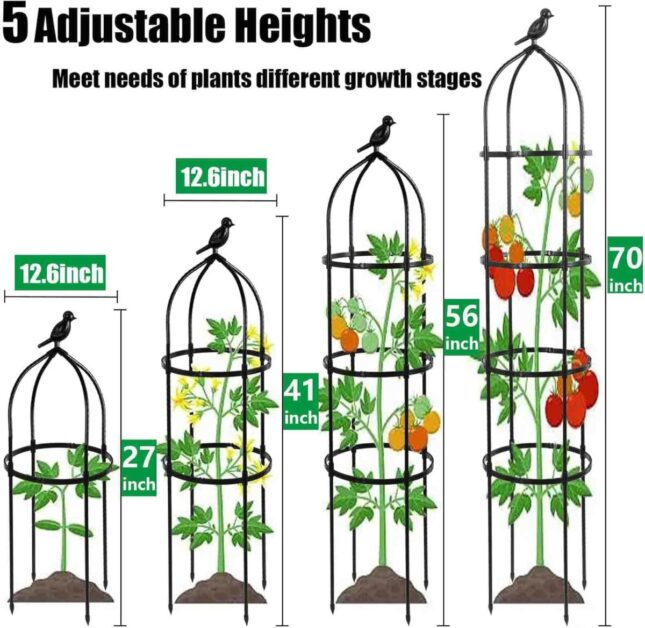
✔ Versatile Design: Suitable for various climbing plants such as vines, roses, and beans, adding aesthetic appeal to any garden or patio.
✔ Space-Saving: Ideal for small gardens or balconies, providing vertical growing space and maximizing limited area.
✔ Easy Assembly: Simple to assemble without the need for special tools, making it convenient for quick setup.
✔ Decorative: Features an obelisk design that adds an elegant touch to outdoor spaces, enhancing the overall garden decor.
✔ Supportive: Provides sturdy support for plants to climb and grow, preventing them from sprawling on the ground and improving air circulation.
✔ Weather Resistant: Designed to withstand outdoor elements, including rain, wind, and sunlight, maintaining its appearance and functionality over time.
✔ Adjustable Height: Can be adjusted to different heights, allowing flexibility in accommodating the growth of various plants.
✔ Multi-Functional: Can be used as a standalone decorative piece or as a support structure for potted plants and climbing vegetables.
❌ Size Limitations: Depending on the size of the trellis, it may not be suitable for large or sprawling plants that require extensive support.
❌ Assembly Required: Requires assembly upon arrival, which may be time-consuming for some users.
❌ Not Adjustable: Some models may not offer adjustable height options, limiting their versatility in accommodating different plant growth stages.
❌ Cost: Depending on the size and material, the trellis may be relatively expensive compared to other support structures.
❌ Maintenance: Requires occasional cleaning to remove dirt and debris, as well as inspection for signs of rust or damage to ensure longevity.
❌ Design Aesthetic: While decorative, the obelisk design may not appeal to all gardeners’ aesthetic preferences.
❌ Weight: Depending on the material, the trellis may be heavy, making it difficult to move or reposition once installed.
❌ Compatibility: Not all plants may be suitable for climbing or may require additional guidance to attach to the trellis effectively.
Preventing and Managing Pests and Diseases in Hydroponic Tomato Gardens
Preventing and managing pests and diseases is crucial for maintaining healthy hydroponic tomato gardens. Without proper care and precautions, these issues can quickly spread and devastate the crops. Here are some effective strategies to control pests and diseases in hydroponic tomato gardens.
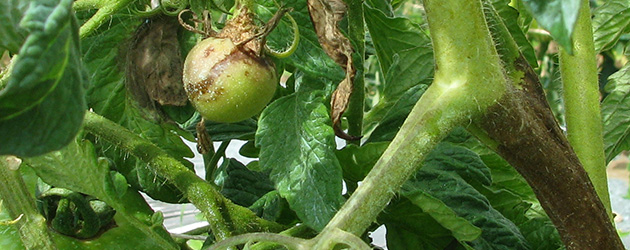
1. Implement strict hygiene practices:
Maintaining cleanliness is essential to prevent the buildup and spread of pests and diseases. Regularly clean and sterilize all equipment, tools, and surfaces in the hydroponic system. Remove any debris or dead plant matter, as they can attract pests or harbor diseases. Additionally, ensure that the growing environment remains free from weeds, as they can serve as hosts for pests and diseases.
2. Monitor and identify pests and diseases:
Regularly inspect the plants for any signs of pests or diseases. Look for visible damage such as holes in leaves, discoloration, deformities, or unusual growth patterns. Use magnifying lenses if necessary to identify tiny insects or their eggs. Be vigilant and proactive in detecting any issues early on, as prompt action is crucial for effective management.
Remember, prevention is always better than cure when it comes to pests and diseases in hydroponic tomato gardens. By implementing these strategies and closely monitoring your plants, you can minimize the risk of infestations and ensure the health and productivity of your hydroponic tomato crops.
Preventing and Managing Pests and Diseases in Hydroponic Tomato Gardens
| Pest/Disease | Prevention | Management |
|---|---|---|
| 1. Aphids | – Companion Planting: Introduce aphid-repelling plants. | – Natural Predators: Introduce beneficial insects like ladybugs or parasitic wasps. |
| – Regular Inspection: Monitor plants for early signs. | – Insecticidal Soap: Apply insecticidal soap as a safe and effective treatment. | |
| – Isolation: Quarantine new plants before introducing. | – Neem Oil: Neem oil can be used as an organic insecticide. | |
| 2. Whiteflies | – Yellow Sticky Traps: Use traps to catch adult whiteflies. | – Biological Controls: Release predatory insects like Encarsia formosa. |
| – Reflective Mulch: Install reflective mulch to deter whiteflies. | – Insecticidal Soap: Apply soap-based sprays for control. | |
| – Maintain Cleanliness: Keep the hydroponic system clean. | – Neem Oil: Neem oil can also help control whiteflies. | |
| 3. Spider Mites | – Humidity Control: Maintain moderate humidity levels. | – Water Spray: Use a strong water spray to dislodge mites. |
| – Beneficial Predators: Introduce predatory mites or insects. | – Miticide Application: Apply a suitable miticide for control. | |
| – Neem Oil: Neem oil has anti-mite properties. | – Regular Monitoring: Inspect plants regularly for signs of infestation. | |
| 4. Powdery Mildew | – Air Circulation: Ensure good airflow around plants. | – Fungicide Treatment: Apply fungicides containing sulfur or potassium bicarbonate. |
| – Reduce Humidity: Maintain lower humidity levels. | – Baking Soda Solution: A mixture of baking soda and water can be used. | |
| – Proper Spacing: Avoid overcrowding of plants. | – Milk Spray: Diluted milk can act as a preventive measure. | |
| 5. Blossom End Rot | – Calcium Supplementation: Ensure sufficient calcium levels. | – Calcium Application: Apply calcium-containing fertilizers. |
| – Maintain Consistent Moisture: Avoid fluctuations in watering. | – pH Adjustment: Ensure the pH of the nutrient solution is within the optimal range. | |
| – Monitor Calcium Uptake: Regularly check for signs of calcium deficiency. | – Mulching: Use mulch to regulate soil moisture levels. | |
| 6. Tomato Hornworms | – Handpicking: Physically remove hornworms from plants. | – Bacillus thuringiensis (Bt): Use Bt-based insecticides for control. |
| – Beneficial Insects: Encourage natural predators like parasitic wasps. | – Neem Oil: Neem oil can be effective against young hornworms. | |
| – Companion Plants: Plant companion herbs to deter hornworms. | – Manual Inspection: Regularly inspect plants for hornworm presence. |
Note: Prevention plays a crucial role in managing pests and diseases in hydroponic tomato gardens. Regular monitoring, early intervention, and a combination of preventive measures contribute to a healthy and thriving tomato crop.
By following these strategies and staying proactive in managing pests and diseases, you can maintain a healthy hydroponic tomato garden. Remember that prevention is key to minimizing infestations and ensuring the productivity of your crops.
Monitoring and Adjusting Environmental Variables for Successful Tomato Growth
To ensure successful tomato growth in a hydroponic system, it is crucial to meticulously monitor and adjust various environmental variables. These variables include lighting, temperature, humidity, and CO2 levels. By maintaining optimal conditions, you can maximize tomato production and overall plant health.
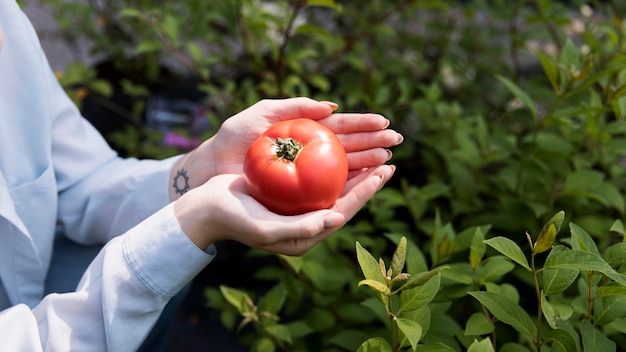
• Lighting is crucial for successful tomato growth in a hydroponic system.
• Tomatoes thrive under intense light with a spectrum that includes blue and red wavelengths.
• Providing 14-16 hours of light each day is important for photosynthesis and healthy growth.
• Grow lights should be placed at an appropriate distance to prevent burning or light stress.
• Temperature control is critical for optimal tomato growth.
• Maintaining a temperature between 70-75°F (21-24°C) during the day and slightly cooler temperatures of 60-65°F (15-18°C) at night is ideal.
• Different tomato varieties may have specific temperature preferences, so it’s important to consider their requirements.
• Humidity levels need close attention in hydroponic tomato cultivation.
• High humidity can lead to increased disease incidence, while low humidity may result in poor seed germination or stunted growth.
• A relative humidity range of 50-70% is generally recommended for tomato plants.
• Carbon dioxide (CO2) levels should also be monitored and adjusted in the hydroponic environment.
• CO2 supplementation can enhance tomato growth and yield significantly.
Increasing CO2 concentration to around 1200-1500 ppm during the day promotes faster photosynthesis and boosts overall plant biomass.
Monitoring these environmental variables requires regular observation and adjustment:
1. Carefully manage lighting, temperature, humidity, and CO2 levels
2. Maintain optimal conditions for tomato plants’ growth
3. Regularly monitor lighting distance to prevent burning or stress
4. Consider specific temperature preferences of different tomato varieties
5. Keep relative humidity within the recommended range of 50-70%
6. Adjust CO2 concentration to enhance photosynthesis
References:
1. Li, Q., Zheng, Y., Yin, G., & Zhao, F. (2020). Impact of supplemental CO2 concentration on growth and photosynthetic characteristics of tomatoes. PeerJ, 8, e8776.
2. Santamaria, P. (2006). Nitrate in vegetables: toxicity, content, intake and EC regulation. Journal of the Science of Food and Agriculture, 86(1), 10-17.
Harvesting and Storing Hydroponic Tomatoes
When it comes to harvesting hydroponic tomatoes, timing is key. The ideal time to harvest tomatoes is when they are fully mature, but not overly ripe. This ensures that they have reached their peak flavor and nutritional value.
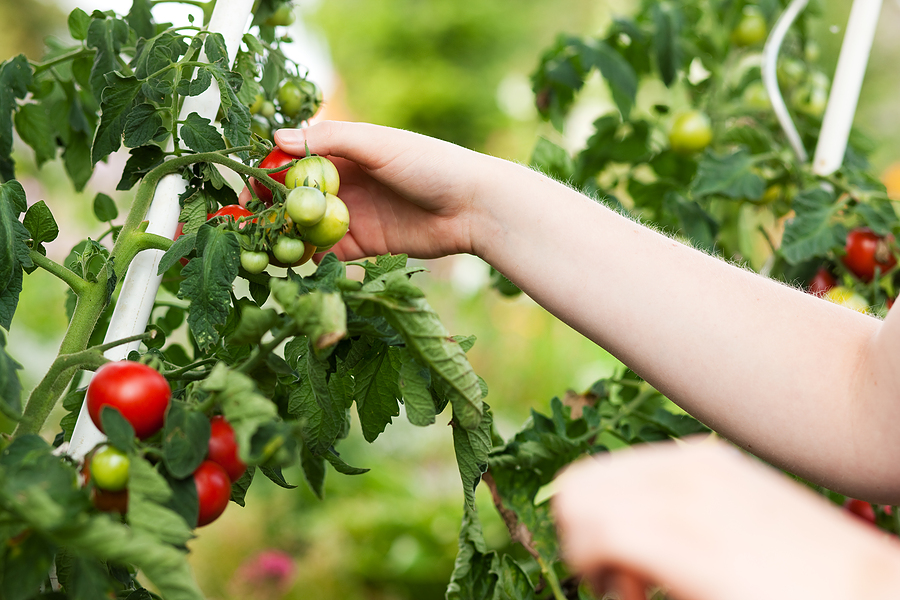
- Check Ripeness: Determine if a tomato is ready for harvest by giving it a gentle squeeze. It should feel firm yet slightly soft. Avoid overripe tomatoes, which feel too soft or mushy.
- Harvesting Technique: Grasp the stem of the tomato fruit and gently twist it away from the plant. Avoid pulling or yanking to prevent damage to the plant and reduce future yields.
- Use Pruning Shears: Use clean and sharp pruning shears or scissors to cut the stem instead of pulling or twisting by hand. This prevents the spread of diseases and ensures a clean cut for faster healing and reduced contamination.
- Storage: After harvesting, place the tomatoes in a clean, ventilated container to avoid bruising or crushing before consumption or further processing.
Remember to handle the tomatoes with care to prevent any damage that could affect their quality during storage or transportation.
Utilizing Hydroponic Tomato Techniques in Other Crop Cultivation
With the increasing popularity and success of hydroponic tomato cultivation, many gardening enthusiasts are now wondering if the techniques used in growing tomatoes hydroponically can be applied to other crops as well. The good news is that the principles and methods applied in hydroponic tomato cultivation can indeed be utilized in cultivating other crops hydroponically.
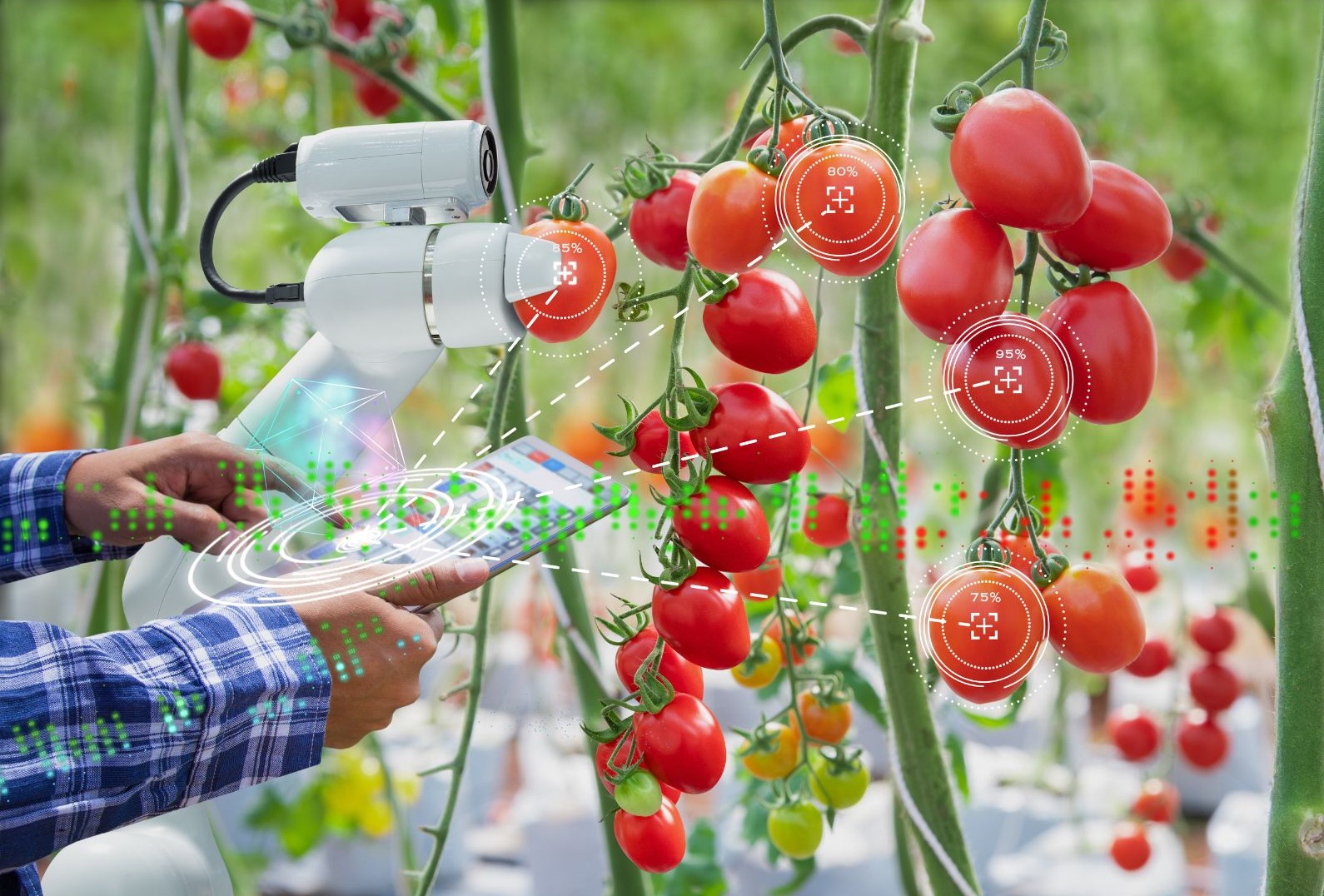
- Controlled Environment:
- Precise Conditions: Hydroponic systems allow growers to fine-tune environmental factors such as nutrient delivery, pH levels, lighting and temperature.
- Optimal Growth: By providing ideal conditions, crops like lettuce, cucumbers, peppers, and herbs can thrive alongside tomatoes.
- Higher Yields and Faster Growth:
- Nutrient Availability: Hydroponically grown plants have constant access to nutrients and water, promoting efficient growth.
- Reduced Risk: Soil-borne diseases and pests are minimized, leading to more reliable harvests.
- Space Efficiency:
- Urban Farming: Vertical farming and compact hydroponic setups maximize crop production in limited spaces.
- Diverse Crops: Urban areas can now cultivate a variety of crops beyond tomatoes.
In conclusion, the techniques developed in hydroponic tomato cultivation can be successfully applied to other crops, providing growers with the ability to optimize conditions for growth, increase yields, and overcome the limitations of traditional soil-based farming. With proper adjustments and considerations, hydroponic cultivation can offer a sustainable and efficient solution for diversifying crop production and meeting the increasing demand for fresh, locally grown produce.
The Future of Pollination-Free Hydroponic Agriculture
As we look towards the future of agriculture, one aspect that is gaining increasing attention and popularity is pollination-free hydroponic techniques. With concerns over declining bee populations and the need for more sustainable and efficient farming methods, hydroponic cultivation provides a viable solution. By eliminating the reliance on natural pollination, growers can cultivate crops such as tomatoes in a controlled environment, ensuring consistent yields and quality.
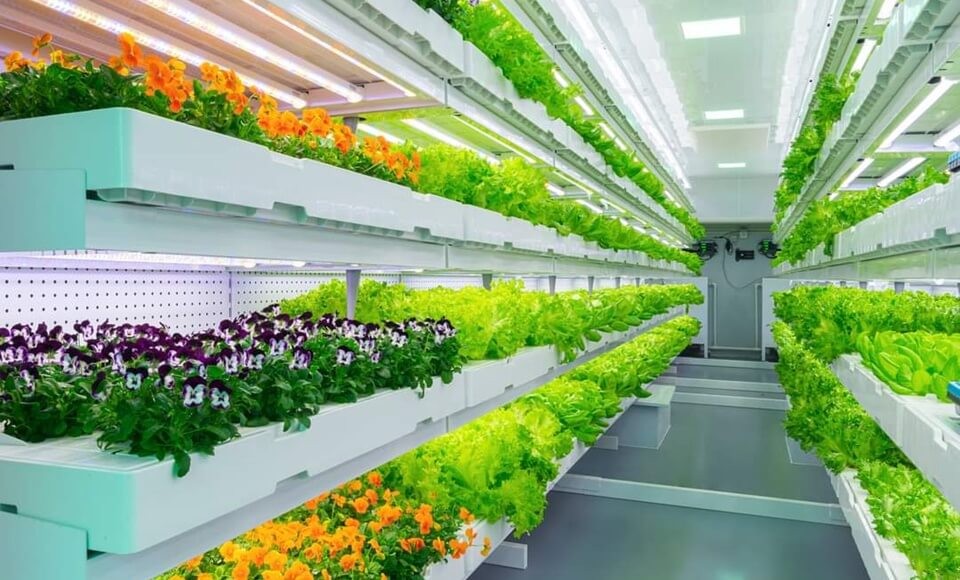
- Artificial Pollination Methods: Pollination-free hydroponics relies on artificial pollination techniques or the selection of self-pollinating varieties, eliminating the need for natural pollinators like bees.
- Controlled Growing Environment: By controlling factors such as lighting, temperature, and nutrient levels, growers can optimize plant growth and productivity without relying on external pollination.
- Advancements in Hydroponic Systems: Recent innovations in hydroponic systems, such as vertical farming and nutrient film techniques, offer space-saving solutions while minimizing water usage and reducing the risk of diseases and pests.
- Future Potential: Pollination-free hydroponic agriculture holds promise for revolutionizing farming practices, enabling year-round cultivation of high-quality crops. Ongoing research and technological advancements are expected to further optimize hydroponic systems and increase the adoption of this sustainable cultivation method.
By embracing pollination-free hydroponic techniques, we can create a more resilient and efficient food production system for generations to come.
Watch video for more information:
FAQ
What is pollination and why is it important in traditional tomato cultivation?
Pollination is the transfer of pollen from the male part of the plant to the female part, leading to fertilization and the production of fruits. In traditional tomato cultivation, pollination by bees or other insects is crucial for fruit set and development.
How does pollination-free hydroponic agriculture work?
Pollination-free hydroponic agriculture involves growing plants, such as tomatoes, in a controlled environment without relying on insects or wind for pollination. This is achieved by using techniques such as hand pollination, self-pollinating varieties, or utilizing certain hydroponic systems that do not require pollination.
What factors should be considered when selecting the right tomato variety for hydroponic growth?
When choosing tomato varieties for hydroponic growth, it is important to consider factors such as their ability to self-pollinate, compact growth habit, disease resistance, and suitability for indoor environments.
How can the ideal hydroponic environment for tomato cultivation be created?
The ideal hydroponic environment for tomato cultivation can be created by controlling factors such as temperature, humidity, lighting, air circulation, and nutrient levels. This ensures optimal growth and productivity.
What are the different hydroponic systems that can be used for pollination-free growth?
There are various hydroponic systems that can be used for pollination-free growth, such as nutrient film technique (NFT), deep water culture (DWC), aeroponics, and drip irrigation systems. Each system has its own advantages and requirements.
How should the hydroponic medium be prepared for tomato planting?
The hydroponic medium, such as rockwool or coconut coir, should be properly cleaned and buffered to adjust pH levels before planting tomato seeds. This ensures a suitable and stable root environment.
Where can high-quality tomato seeds for hydroponic cultivation be sourced?
High-quality tomato seeds for hydroponic cultivation can be sourced from reputable seed suppliers, agricultural universities, or specialized hydroponic equipment manufacturers. It is important to choose seeds specifically bred for hydroponic conditions.
How should tomato seeds be planted in the hydroponic system?
Tomato seeds can be started in small containers with a suitable growing medium, placed in the hydroponic system once they have germinated, and carefully transplanted into the main hydroponic setup. Follow the specific instructions provided by the seed supplier or hydroponic system manufacturer.
What are the optimal lighting and temperature conditions for tomato growth in a hydroponic system?
Tomatoes require around 12-16 hours of light per day, provided by high-intensity discharge (HID) lamps or LED grow lights. The temperature should be maintained between 70-80°F (21-27°C) during the day and slightly cooler at night.
How can the pH and nutrient levels in the hydroponic solution be maintained?
The pH of the hydroponic solution should be regularly monitored and adjusted using pH buffers. Nutrient levels can be maintained by following a nutrient feeding schedule, ensuring all essential elements are provided in the right proportions.
What is the recommended watering and feeding schedule for hydroponic tomatoes?
Hydroponic tomatoes generally require frequent but controlled watering to maintain moisture levels in the root zone. Feeding should be done according to a scheduled nutrient solution application, providing a balanced mix of essential nutrients.
How should tomato plants be pruned and trained for maximum yields in a hydroponic system?
Tomato plants in a hydroponic system should be pruned to remove excessive foliage and encourage vertical growth. Training techniques such as trellising or using support systems can help manage plant growth, improve air circulation, and increase fruit production.
How can pests and diseases be prevented and managed in hydroponic tomato gardens?
Pest and disease prevention in hydroponic tomato gardens can be achieved by implementing strict hygiene practices, monitoring for signs of infestation or disease, using biological controls or organic pesticides, and ensuring proper ventilation and air circulation.
What environmental variables should be monitored and adjusted for successful tomato growth in a hydroponic system?
Environmental variables such as temperature, humidity, light intensity, CO2 levels, and nutrient concentrations should be regularly monitored and adjusted as needed to provide optimal growing conditions for hydroponic tomatoes.
How should hydroponic tomatoes be harvested and stored?
Hydroponic tomatoes should be harvested when they are fully ripe and have reached the desired size and color. Care should be taken to avoid damaging the fruits during harvest. They can be stored in a cool, dry place for a short period or consumed immediately for maximum freshness.
Can the techniques used for pollination-free hydroponic tomato cultivation be applied to other crops?
Yes, the techniques used for pollination-free hydroponic tomato cultivation can be applied to other crops that do not require insect pollination, such as leafy greens, herbs, or certain varieties of cucumbers and peppers. However, each crop may have its specific requirements and considerations.
What does the future hold for pollination-free hydroponic agriculture?
The future of pollination-free hydroponic agriculture looks promising, with advancements in technology and plant breeding allowing for increased productivity and efficiency. This method of cultivation offers opportunities for sustainable and controlled production of fresh food, especially in urban areas or regions with limited access to arable land.

Studied Agricultural Engineering-Plant Protection at University of California, Davis.
Head of Content writing team at Southelmontehydroponics.com

